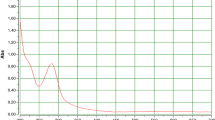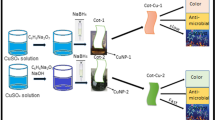Abstract
N-doped copper oxide nanoparticles with different sizes and shapes were chemically synthesized on bleached cotton fabric. Various analysis methods including XRD, EDX, SEM, FTIR and UV-Vis were used to determine the presence, structure, shape, size and morphology of the nanoparticles. The effect of temperature, pH and processing time was studied to optimize the conditions for producing small nanoparticles with narrow size distribution and low agglomeration. Wheat-like and spherical shaped N-doped copper oxide nanoparticles were in situ synthesized on cotton fiber with different loadings. The treated cotton fabrics indicated higher hydrophobicity, tenacity, tensile stress and elongation. Further, the treated cotton fabrics showed considerable antibacterial properties against a gram-positive S. aureus and a gram-negative E. coli bacteria. The release of nanoparticles in the washing bath was measured by atomic absorption confirmed the reasonable durability and safety of the treated fabrics. Overall, the cotton fabrics treated with CuO nanoparticles have potential application in electronics as well as medical and technical textiles.








Similar content being viewed by others
References
Allahyarzadeh V, Montazer M, Hemmatinejad N, Samadi N (2013) In situ synthesis of nano silver on polyester using NaOH/Nano TiO2. J Appl Polym Sci 129:892–900
Anyaogu KC, Fedorov AV, Neckers DC (2008) Synthesis, characterization, and antifouling potential of functionalized copper nanoparticles. Langmuir 24:4340–4346
Applerot G, Lellouche J, Lipovsky A, Nitzan Y, Lubart R, Gedanken A, Banin E (2012) Understanding the antibacterial mechanism of CuO nanoparticles: revealing the route of induced oxidative stress. Small 8:3326–3337
Ashraf S, Saif-ur-Rehman Sher F, Khalid ZM, Mehmood M, Hussain I (2014) Synthesis of cellulose–metal nanoparticle composites: development and comparison of different protocols. Cellulose 21:395–405
Bang JH, Suslick KS (2010) Applications of ultrasound to the synthesis of nanostructured materials. Adv Mater 22:1039–1059
Behzadnia A, Montazer M, Rashidi A, Mahmoudi-Rad M (2014) Rapid Sonosynthesis of N-doped nano TiO2 on wool fabric at low temperature: introducing self-cleaning, hydrophilicity, antibacterial/antifungal properties with low alkali solubility, yellowness and cytotoxicity. Photochem Photobiol 90:1224–1233
Cady NC, Behnke JL, Strickland AD (2011) Copper-based nanostructured coatings on natural cellulose: nanocomposites exhibiting rapid and efficient inhibition of a multi-drug resistant wound pathogen, A. baumannii, and mammalian cell biocompatibility in vitro. Adv Funct Mater 21:2506–2514
Cao G (2004) Nanostructures and nanomaterials: synthesis. Imperial College Press, London, Properties and Applications
Carnes CL, Stipp J, Klabunde KJ (2002) Synthesis, characterization, and adsorption studies of nanocrystalline copper oxide and nickel oxide. Langmuir 18:1352–1359
Coates J (2000) Interpretation of infrared spectra, a practical approach. In: Meyers RA (ed) Encyclopedia of analytical chemistry. Wiley, Chichester, pp 10815–10837
El-Nahhal IM, Zourab SM, Kodeh FS, Semane M, Genois I, Babonneau F (2012) Nano-structured copper oxide-cotton fibers: synthesis, characterization and applications. Int Nano Lett 2:62–67
Etefagh R, Azhir E, Shahtahmasebi N (2013) Synthesis of CuO nanoparticles and fabrication of nanostructural layer biosensors for detecting Aspergillus niger fungi. Sci Iran F 20:1055–1058
Gabbay J, Mishal J, Magen E, Zatcoff R, Shemer-Avni Y, Borkow G (2006) Copper oxide impregnated textiles with potent biocidal activities. J Ind Text 35:323–335
Garnovskii AD, Kharissov BI (2003) Synthetic coordination and organometallic chemistry. CRC Press, New York
Giordanino F, Borfecchia E, Lomachenko KA, Lazzarini A, Agostini G, Gallo E, Soldatov AV, Beato P, Bordiga S, Lamberti C (2014) Interaction of NH3 with Cu-SSZ-13 catalyst: a complementary FTIR, XANES, and XES Study. J Phys Chem Lett 5:1552–1559
Hans M, Erbe A, Mathews S, Chen Y, Solioz M, Mucklich F (2013) Role of copper oxides in contact killing of bacteria. Langmuir 29:16160–16166
Harifi T, Montazer M (2014) Photo-, bio-, and magneto-active colored polyester fabric with hydrophobic/hydrophilic and enhanced mechanical properties through synthesis of TiO2/Fe3O4/Ag nanocomposite. Ind Eng Chem Res 53:1119–1129
Hassan IA, Parkin IP, Nair SP, Carmalt CJ (2014) Antimicrobial activity of copper and copper (I) oxide thin films deposited via aerosol-assisted CVD. J Mater Chem B 2:2855–2860
Helios K, Wysokiński R, Pietraszko A, Michalska D (2011) Vibrational spectra and reinvestigation of the crystal structure of a polymeric copper(II)–orotate complex, [Cu(μ-HOr)(H2O)2]n: the performance of new DFT methods, M06 and M05-2X, in theoretical studies. Vib Spectrosc 55:207–215
Hun JJ, Jae WC, Sang HL, Seok WH (2012) Acute toxicity of Ag and CuO nanoparticle suspensions against Daphnia magna: the importance of their dissolved fraction varying with preparation methods. J Hazard Mater 301:227–228
Jia B, Mei Y, Cheng L, Zhou J, Zhang L (2012) Preparation of copper nanoparticles coated cellulose films with antibacterial properties through one-step reduction. ACS Appl Mater Interfaces 4:2897–2902
Klemm D, Philipp B, Heinze T, Heinze U, Wagenknecht W (1998) Comprehensive Cellulose Chemistry (Vol 2). Wiley-VCH Verlag, Weinheim, Functionalization of Cellulose
Kosmulski M (2009) pH-dependent surface charging and points of zero charge. IV. Update and new approach. J Colloid Interface Sci 337:439–448
Kotelnikova N, Vainio U, Pirkkalainen K, Serimaa R (2007) Novel approaches to metallization of cellulose by reduction of cellulose-incorporated copper and nickel ions. Macromol Symp 254:74–79
Lam YL, Kan CW, Yuen CWM (2012) Developments in functional finishing of cotton fibres: wrinkle-resistant, flame-retardant and antimicrobial treatments. Text Prog 44:175–249
Mageshwari K, Sathyamoorthy R (2013) Organic free synthesis of flower-like hierarchical CuO microspheres by reflux condensation approach. Appl Nanosci 3:161–166
Montazer M, Maali-Amiri M (2014) ZnO nano reactor on textiles and polymers: ex situ and in situ synthesis, application, and characterization. J Phys Chem B 118:1453–1470
Oskam G (2006) Metal oxide nanoparticles: synthesis, characterization and application. J Sol–Gel Sci Technol 37:161–164
Perelshtein I, Ruderman Y, Perkas N, Beddow J, Singh G, Vinatoru M, Joyce E, Mason JT, Blanes M, Molla K, Gedanken A (2013) The sonochemical coating of cotton withstands 65 washing cycles at hospital washing standards and retains its antibacterial properties. Cellulose 20:1215–1221
Perreault F, Oukarroum A, Melegari SP, Matias WG, Popovic R (2012) Polymer coating of copper oxide nanoparticles increases nanoparticles uptake and toxicity in the green alga Chlamydomonas reinhardtii. Chemosphere 87:1388–1394
Poortavasoly H, Montazer M, Harifi T (2014) Simultaneous synthesis of nano silver and activation of polyester producing higher tensile strength aminohydroxylated fiber with antibacterial and hydrophilic properties. RSC Adv 4:46250–46256
Rubilar O, Rai M, Tortella G, Diez MC, Seabra AB, Durán N (2013) Biogenic nanoparticles: copper, copper oxides, copper sulphides, complex copper nanostructures and their applications. Biotechnol Lett 35:1365–1375
Sarkar S, Guibal E, Quignard F, SenGupta AK (2012) Polymer-supported metals and metal oxide nanoparticles: synthesis, characterization, and applications. J Nanopart Res 14:715–738
Sedighi A, Montazer M, Hemmatinejad N (2014a) Copper nanoparticles on bleached cotton fabric: in situ synthesis and characterization. Cellulose 21:2119–2132
Sedighi A, Montazer M, Samadi N (2014b) Synthesis of nano Cu2O on cotton: morphological, physical, biologicaland optical sensing characterizations. Carbohydr Polym 110:489–498
Shahidi S, Aslan N, Ghoranneviss M, Korachi M (2014) Effect of thymol on the antibacterial efficiency of plasma-treated cotton fabric. Cellulose 21:1933–1943
Subramanian B, Priya KA, Rajan ST, Dhandapani P, Jayachandran M (2014) Antimicrobial activity of sputtered nanocrystalline CuO impregnated fabrics. Mater Lett 128:1–4
Torres A, Ruales C, Pulgarin C, Aimable A, Bowen P, Sarria V, Kiwi J (2010) Innovative high-surface-area cuo pretreated cotton effective in bacterial inactivation under visible light. ACS Appl Mater Interfaces 2:2547–2552
Vaseem M, Umar A, Hahn YB (2008) Low-temperature growth and properties of CuO structures prepared by aqueous solution process. J Nanosci Nanotechnol 8:5511–5515
Zhang G, Liu Y, Morikawa H, Chen Y (2013) Application of ZnO nanoparticles to enhance the antimicrobial activity and ultraviolet protective property of bamboo pulp fabric. Cellulose 20:1877–1884
Author information
Authors and Affiliations
Corresponding author
Rights and permissions
About this article
Cite this article
Sedighi, A., Montazer, M. Tunable shaped N-doped CuO nanoparticles on cotton fabric through processing conditions: synthesis, antibacterial behavior and mechanical properties. Cellulose 23, 2229–2243 (2016). https://doi.org/10.1007/s10570-016-0892-3
Received:
Accepted:
Published:
Issue Date:
DOI: https://doi.org/10.1007/s10570-016-0892-3




